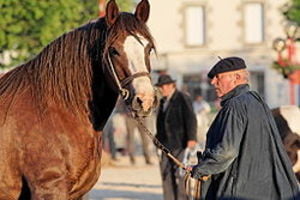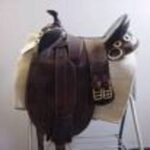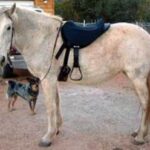The Breton is the most popular draft horse breed in France. Unfortunately, this is because the Breton is the favoured horse breed for eating. Those that are spared from the dinner table admirably work in harness, agriculture and even under saddle. Bretons work in vineyards, farmers’ fields and along shorelines to gather valuable seaweed. Bretons have been bred in several countries other than France, but only those Bretons foaled in Brittany are allowed in the official stud book, Syndicat des Elevuers Cheval Breton.
The Breton has thought to have been one of the foundation breeds for the Canadian horse, which in turn is thought to have exerted a tremendous influence on many North American breeds now extinct or still existing.
History
Ask ten Breton enthusiasts about the history of their beloved breed and you’ll get ten different answers. Although classified as a French breed, “International Encyclopedia of Horse Breeds” (University of Oklahoma Press, 1995) puts forward the theory that the breed originated in the UK and was brought over to France during various wars, where it was developed even further.
Considering the strength, grace and high action of the Breton’s gaits, it takes little imagination to picture a knight on his back riding into battle or for a jousting tournament. But no matter where the Breton developed, it was France that was its stronghold. France began the first Breton studbook in 1909.
One of the most famous Bretons in France was named Naous (1934 – 1951). He was exceptionally handsome, friendly and prepotent. A rather impressive statue of the stallion stands in Callac, France. The area still holds a large equine festival every September which features Bretons.
General Appearance
Bretons are a harmonious balance of power and grace, no matter what type they are. Currently, there are three types although there were several other types around the time of the Crusades. These types are the Corlay or Central Mountain Breton, thought to be the oldest of the types; the Postier Breton, which is slimmer and the Heavy Draft Breton, which is the largest type and is preferred for meat.
No matter what their type, Bretons range from 14.3 to 16.2 hands high, with a lot of muscle, solid legs without much feathering and good hooves. Their heads are usually straight or slightly dished in profile with wide eyes and small ears. Their facial expressions are a highlight among the breed. They seem truly altert and curious about everything that’s going on about them and do not have the dull look of some other heavy draft breeds.
Their manes and tails are very thick, but in France the tails are docked. The reason is that the tails supposedly get caught up in harness and break the tailbone. Bretons most often come in various shades of chestnut, but also come in roan, bay and occasionally grey. White facial markings are common.
Refernces:
“The Ultimate Horse Book.” Elwyn Hartley Edwards. Dorling Kindersley; 1991.
“International Encyclopedia of Horse Breeds.” Bonnie Hendricks. University of Oklahoma Press, 1995.
Wikipedia. “Breton (horse.)” http://en.wikipedia.org/wiki/Breton_(horse)
Callac, France. http://www.callac.info/




